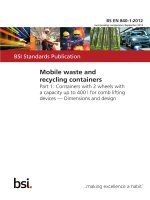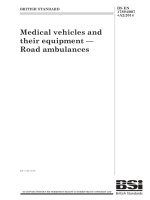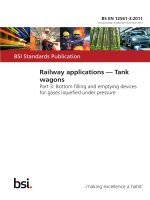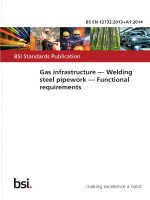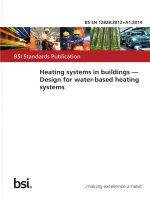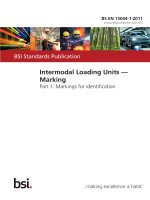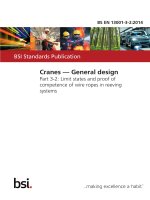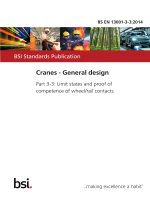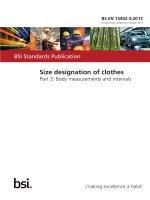Bsi bs en 16602 70 45 2014
Bạn đang xem bản rút gọn của tài liệu. Xem và tải ngay bản đầy đủ của tài liệu tại đây (1.54 MB, 36 trang )
BS EN 16602-70-45:2014
BSI Standards Publication
Space product assurance —
Mechanical testing of metallic
materials
BS EN 16602-70-45:2014
BRITISH STANDARD
National foreword
This British Standard is the UK implementation of
EN 16602-70-45:2014.
The UK participation in its preparation was entrusted to Technical
Committee ACE/68, Space systems and operations.
A list of organizations represented on this committee can be
obtained on request to its secretary.
This publication does not purport to include all the necessary
provisions of a contract. Users are responsible for its correct
application.
© The British Standards Institution 2014.
Published by BSI Standards Limited 2014
ISBN 978 0 580 86586 2
ICS 49.025.01; 49.140
Compliance with a British Standard cannot confer immunity from
legal obligations.
This British Standard was published under the authority of the
Standards Policy and Strategy Committee on 30 November 2014.
Amendments/corrigenda issued since publication
Date
Text affected
EN 16602-70-45
EUROPEAN STANDARD
NORME EUROPÉENNE
EUROPÄISCHE NORM
October 2014
ICS 49.025.01; 49.140
English version
Space product assurance - Mechanical testing of metallic
materials
Assurance produit des projets spatiaux - Essais
mécaniques des matériaux métalliques
Raumfahrtproduktsicherung - Mechanische Tests von
metallenem Material
This European Standard was approved by CEN on 18 October 2014.
CEN and CENELEC members are bound to comply with the CEN/CENELEC Internal Regulations which stipulate the conditions for giving
this European Standard the status of a national standard without any alteration. Up-to-date lists and bibliographical references concerning
such national standards may be obtained on application to the CEN-CENELEC Management Centre or to any CEN and CENELEC
member.
This European Standard exists in three official versions (English, French, German). A version in any other language made by translation
under the responsibility of a CEN and CENELEC member into its own language and notified to the CEN-CENELEC Management Centre
has the same status as the official versions.
CEN and CENELEC members are the national standards bodies and national electrotechnical committees of Austria, Belgium, Bulgaria,
Croatia, Cyprus, Czech Republic, Denmark, Estonia, Finland, Former Yugoslav Republic of Macedonia, France, Germany, Greece,
Hungary, Iceland, Ireland, Italy, Latvia, Lithuania, Luxembourg, Malta, Netherlands, Norway, Poland, Portugal, Romania, Slovakia,
Slovenia, Spain, Sweden, Switzerland, Turkey and United Kingdom.
CEN-CENELEC Management Centre:
Avenue Marnix 17, B-1000 Brussels
© 2014 CEN/CENELEC All rights of exploitation in any form and by any means reserved
worldwide for CEN national Members and for CENELEC
Members.
Ref. No. EN 16602-70-45:2014 E
BS EN 16602-70-45:2014
EN 16602-70-45:2014 (E)
Table of contents
Foreword .................................................................................................................... 5
1 Scope ....................................................................................................................... 6
2 Normative references ............................................................................................. 7
3 Terms, definitions and abbreviated terms............................................................ 9
3.1
Terms defined in other standards .............................................................................9
3.2
Terms specific to the present standard .....................................................................9
3.3
Abbreviated terms...................................................................................................10
3.4
Symbols ..................................................................................................................11
4 Principles .............................................................................................................. 12
4.1
Overview ................................................................................................................12
4.2
Tensile test .............................................................................................................12
4.3
Fracture toughness test ..........................................................................................12
4.4
4.5
4.3.1
Overview ...................................................................................................12
4.3.2
Determination of fracture toughness using the KIc test method .................. 12
4.3.3
Determination of fracture toughness using the JIc test method .................. 13
4.3.4
Characterization of fracture toughness using the R-curve test method ...... 13
4.3.5
Characterization of fracture toughness using the CTOD test method ........ 13
Fatigue test .............................................................................................................14
4.4.1
General .....................................................................................................14
4.4.2
Force controlled constant amplitude axial fatigue test ............................... 14
4.4.3
Strain-controlled fatigue test...................................................................... 14
Fatigue crack propagation test ................................................................................14
4.5.1
Stable crack growth rate............................................................................ 14
4.5.2
Crack propagation threshold ..................................................................... 15
4.6
Fracture and fatigue test in special environment ..................................................... 15
4.7
Stress corrosion cracking test .................................................................................15
4.7.1
Overview ...................................................................................................15
4.7.2
Stress corrosion cracking test using smooth specimens ........................... 15
4.7.3
Stress corrosion cracking test using pre-cracked specimens .................... 16
BS EN 16602-70-45:2014
EN 16602-70-45:2014 (E)
4.8
Creep test ...............................................................................................................16
4.9
Test results presentation.........................................................................................16
5 Requirements........................................................................................................ 17
5.1
Customer agreement ..............................................................................................17
5.2
Tensile testing ........................................................................................................17
5.3
5.4
5.5
5.2.1
General .....................................................................................................17
5.2.2
Tensile testing of weldments ..................................................................... 17
Fracture toughness test ..........................................................................................18
5.3.1
KIc test method ..........................................................................................18
5.3.2
JIc test method...........................................................................................18
5.3.3
R-curve test method ..................................................................................18
5.3.4
CTOD test method ....................................................................................18
Fatigue test .............................................................................................................19
5.4.1
Force controlled constant amplitude axial fatigue test ............................... 19
5.4.2
Strain-controlled fatigue test...................................................................... 19
Fatigue crack propagation test ................................................................................20
5.5.1
Determination of fatigue crack growth rate ................................................ 20
5.5.2
Determination of a fatigue crack propagation threshold ............................. 20
5.6
Fracture and fatigue tests in special environments ................................................. 21
5.7
Stress corrosion cracking test .................................................................................21
5.7.1
Stress corrosion cracking test using smooth specimens ........................... 21
5.7.2
Stress corrosion cracking test using pre-cracked specimens .................... 21
5.8
Creep test ...............................................................................................................21
5.9
Evaluation of test results .........................................................................................21
5.10 Storage ...................................................................................................................22
5.11 Reporting ................................................................................................................22
5.12 Quality assurance ...................................................................................................22
5.12.1
General .....................................................................................................22
5.12.2
Calibration .................................................................................................22
5.12.3
Quality control of raw materials ................................................................. 23
5.12.4
Nonconformance .......................................................................................23
5.12.5
Traceability and records ............................................................................ 23
Annex A (normative) Request for mechanical testing of materials – DRD ......... 24
Annex B (normative) Proposal for mechanical testing of materials – DRD........ 26
Annex C (normative) Report of mechanical testing of materials – DRD ............. 28
BS EN 16602-70-45:2014
EN 16602-70-45:2014 (E)
Annex D (informative) References ......................................................................... 31
Bibliography............................................................................................................. 32
BS EN 16602-70-45:2014
EN 16602-70-45:2014 (E)
Foreword
This document (EN 16602-70-45:2014) has been prepared by Technical
Committee CEN/CLC/TC 5 “Space”, the secretariat of which is held by DIN.
This standard (EN 16602-70-45:2014) originates from ECSS-Q-ST-70-45C.
This European Standard shall be given the status of a national standard, either
by publication of an identical text or by endorsement, at the latest by April 2015,
and conflicting national standards shall be withdrawn at the latest by April
2015.
Attention is drawn to the possibility that some of the elements of this document
may be the subject of patent rights. CEN [and/or CENELEC] shall not be held
responsible for identifying any or all such patent rights.
This document has been prepared under a mandate given to CEN by the
European Commission and the European Free Trade Association.
This document has been developed to cover specifically space systems and has
therefore precedence over any EN covering the same scope but with a wider
domain of applicability (e.g. : aerospace).
According to the CEN-CENELEC Internal Regulations, the national standards
organizations of the following countries are bound to implement this European
Standard: Austria, Belgium, Bulgaria, Croatia, Cyprus, Czech Republic,
Denmark, Estonia, Finland, Former Yugoslav Republic of Macedonia, France,
Germany, Greece, Hungary, Iceland, Ireland, Italy, Latvia, Lithuania,
Luxembourg, Malta, Netherlands, Norway, Poland, Portugal, Romania,
Slovakia, Slovenia, Spain, Sweden, Switzerland, Turkey and the United
Kingdom.
BS EN 16602-70-45:2014
EN 16602-70-45:2014 (E)
1
Scope
This Standard specifies requirements for mechanical testing of metallic
materials to be used in the fabrication of spacecraft hardware.
This Standard establishes the requirements for most relevant test methods
carried out to assess the tensile, fatigue and fracture properties of metallic
materials. It does not give a complete review of all the existing test methods for
the evaluation of mechanical properties of metallic materials.
Furthermore, this Standard specifies requirements for the evaluation,
presentation and reporting of test results.
This standard may be tailored for the specific characteristic and constrains of a
space project in conformance with ECSS-S-ST-00.
BS EN 16602-70-45:2014
EN 16602-70-45:2014 (E)
2
Normative references
The following normative documents contain provisions which, through
reference in this text, constitute provisions of this ECSS Standard. For dated
references, subsequent amendments to, or revision of any of these publications
do not apply, However, parties to agreements based on this ECSS Standard are
encouraged to investigate the possibility of applying the more recent editions of
the normative documents indicated below. For undated references, the latest
edition of the publication referred to applies.
EN reference
Reference in text
Title
EN 16601-00-01
ECSS-S-ST-00-01
ECSS system — Glossary of terms
EN 16602-10-09
ECSS-Q-ST-10-09
Space product assurance — Nonconformance control
system
EN 16602-70
ECSS-Q-ST-70
Space product assurance — Materials, mechanical
parts and processes
EN 16602-70-37
ECSS-Q-ST-70-37
Space product assurance — Determination of the
susceptibility of metals to stress-corrosion cracking
EN 16602-70-46
ECSS-Q-ST-70-46
Space product assurance — Requirements for
manufacturing and procurement of threaded
fasteners
ASTM E 139
Standard test methods for conducting creep, creeprupture, and stress-rupture tests of metallic materials
ASTM E 399
Standard test method for plane-strain fracture
toughness of metallic materials
ASTM E 466
Standard practice for conducing force controlled
constant amplitude axial fatigue tests of metallic
materials
ASTM E 561
Standard practice for R-curve determination
ASTM E 606
Standard practice for strain-controlled fatigue testing
ASTM E 647
Standard test method for measurement of fatigue
crack growth rates
ASTM E 739
Standard practice for statistical analysis of linear or
linarized stress-life (SN) and strain-life (e-N) fatigue
BS EN 16602-70-45:2014
EN 16602-70-45:2014 (E)
data
ASTM E 1290
Standard test method for crack-tip opening displacement (CTOD) fracture toughness measurement
ASTM E 1820
Standard test method for measurement of fracture
toughness
EN 10002-1
Metallic materials — Tensile testing — Part 1:
Method of test at ambient temperature
EN 10002-2
Metallic materials — Tensile testing — Part 2:
Verification of the force measuring system of the
tensile testing machines
EN 10002-4
Metallic materials — Tensile testing — Part 4:
Verification of the extensometers used in uniaxial
testing
ESDU 96013:1996
Fracture toughness (KIc) values of some aluminium
alloys
ISO 7539-6:2003
Corrosion of metals and alloys — Stress corrosion
testing — Part 6: Preparation and use of pre-cracked
specimens for tests under constant load or constant
displacement
BS EN 16602-70-45:2014
EN 16602-70-45:2014 (E)
3
Terms, definitions and abbreviated terms
3.1
Terms defined in other standards
For the purpose of this Standard, the terms and definitions from
ECSS-S-ST-00-01 and ECSS-Q-ST-70 apply.
3.2
Terms specific to the present standard
3.2.1
crack tip plastic zone
plastically deformed region in a material adjacent to a crack tip
3.2.2
creep
time-dependent increase in strain in a material resulting from force
3.2.3
damage tolerance
in a material or structure, the capability to withstand stresses or loads in the
presence of defects
3.2.4
failure
condition generally caused by break or collapse so that a structural element can
no longer fulfil its purpose
3.2.5
fatigue
in a material, the failure phenomenon which results from repeated fluctuation
of stress
3.2.6
fracture toughness
inherent resistance of a material in the presence of a crack-like defect
3.2.7
finite life range
life range, in which all test pieces before a predetermined number of cycles fail
BS EN 16602-70-45:2014
EN 16602-70-45:2014 (E)
3.2.8
mechanical properties
those properties of a material that are associated with elastic and inelastic
reaction when force is applied, or that involve the relationship between stress
and strain
3.2.9
mechanical testing
determination of mechanical properties
3.2.10
raw material
material from which specimens are manufactured
3.2.11
specimen
representative fraction of material tested or analysed in order to determine
mechanical properties
3.2.12
transition range
predetermined number of cycles of stress cycles (typically 5 x 10-6 to 5 x 10-7
cycles), where failure as well as non-failure occur.
3.2.13
threaded fastener
device composed by a cylindrical screwed bar provided with a head and a
metal collar, screwed internally, to fit the cylindrical bar that is to hold parts
firmly together in an assembly
3.2.14
weld heat affected zone (HAZ)
portion of material in a welded joint whose microstructure and physical
properties are affected by the heat input during welding
3.3
Abbreviated terms
For the purpose of this Standard, the abbreviated terms from ECSS-S-ST-00-01
and the following apply:
Abbreviation
Meaning
ASTM
American Society for Testing and Materials
CEN
European Committee for Standardization
CTOD
crack tip opening displacement
ESDU
engineering sciences data unit
HAZ
heat affected zone
ISO
International Organization for Standardization
NCR
nonconformance report
NDI
non-destructive inspection
RMC
raw material certificate
BS EN 16602-70-45:2014
EN 16602-70-45:2014 (E)
3.4
Symbols
Symbol
Meaning
C(T)
compact tension specimen
J
J-integral
JIc
J-integral plane-strain fracture toughness
K
stress intensity factor
KIc
stress intensity plane-strain fracture toughness
Kmax
maximum stress intensity factor
Mode I
opening mode of loading
R
stress ratio
Rsx
specimen stress ratio
M(T)
middle tension specimen
da/dn
crack growth rate
ΔK
stress intensity factor range
ΔKth
fatigue crack propagation threshold
KISCC
threshold stress intensity factor for susceptibility
to stress corrosion cracking
BS EN 16602-70-45:2014
EN 16602-70-45:2014 (E)
4
Principles
4.1
Overview
This Standard specifies requirements to conduct tests in order to characterize
mechanical behaviour and properties of metallic materials. Selection criteria of
mechanical tests are based on the significance and use of each specified test
method. Test methods, which are covered in this Standard, are characterized in
the following paragraphs.
4.2
Tensile test
Tensile tests provide information on the strength and ductility of materials
under uniaxial tensile stresses. Test results can be used in comparing materials,
alloy development, design and quality control. The test method covers the
tension testing of metallic materials in any form at room temperature, and
specifically the methods determine yield strength, yield point elongation,
tensile strength, elongation and reduction of area.
4.3
Fracture toughness test
4.3.1
Overview
This test refers to methods to determine fracture toughness of metallic materials
using the following parameters: stress intensity factor (K), J-integral (J), R-curve
and crack tip opening displacement (CTOD). The fracture toughness
determined in accordance with this method is for opening mode (Mode I) of
loading.
4.3.2
Determination of fracture toughness using
the KIc test method
This method provides the measurement of crack-extension resistance at the
start of a crack extension for slow rates of loading and when the crack-tip
BS EN 16602-70-45:2014
EN 16602-70-45:2014 (E)
plastic zone is small compared to both the crack size and to the specimen
dimension in the direction of the constraint.
The method covers the determination of linear elastic plane-strain fracture
toughness (KIc) of metallic materials by tests using a variety of fatigueprecracked specimens.
4.3.3
Determination of fracture toughness using
the JIc test method
This method provides the measurement of crack-extension resistance near the
onset of stable crack extension for slow rates of loading and substantial plastic
deformation.
The method covers the determination of the J-integral plane-strain fracture
toughness (JIc) of metallic materials.
4.3.4
Characterization of fracture toughness
using the R-curve test method
This method provides a characterization of the resistance to fracture of metallic
materials during incremental slow stable crack extension and result from
growth of the plastic zone as the crack extends from a sharp notch. Materials
that can be tested for R-curve development are not limited by strength,
thickness, or toughness provided that specimens are of sufficient size to remain
predominantly elastic.
The method covers the determination of resistance to fracturing of metallic
materials by R-curves obtained by testing compact tension specimens C(T) or
middle tension specimens M(T).
4.3.5
Characterization of fracture toughness
using the CTOD test method
This test method provides a characterization of the fracture toughness of
metallic materials and is used for materials that exhibit a change from ductile to
brittle behaviour with decreasing temperature. This method is also used to
characterize the toughness of materials for which the properties and thickness
of interest preclude the determination of KIc fracture toughness in accordance
with ASTM E 399.
The specimen dimensions can affect the values of CTOD. For this reason
specimens of same dimensions are used when comparing test results.
The method covers the determination of critical crack tip opening displacement
(CTOD) values at one or more of several crack extension events. These CTOD is
used as measures of fracture toughness for metallic materials.
BS EN 16602-70-45:2014
EN 16602-70-45:2014 (E)
4.4
Fatigue test
4.4.1
General
Fatigue test refers to tests methods for the determination of fatigue strength of
metallic materials subjected to constant amplitude cycling loading.
4.4.2
Force controlled constant amplitude axial
fatigue test
The force controlled axial fatigue test is used to determine the effect of
variations in stress, material, geometry and surface condition on the fatigue
resistance of materials subjected to fatigue loading. The results can also be used
as a guideline for the selection of metallic materials for service under conditions
of repeated direct stress.
The method covers axial force controlled fatigue tests to obtain the fatigue
strength of materials in the fatigue regime, where the strains are predominately
elastic throughout the test.
4.4.3
Strain-controlled fatigue test
Strain-controlled fatigue is important for situations in which components or
portions of components undergo either mechanically or thermally induced
cyclic plastic strains that cause failure within relatively few cycles (i.e. fatigue
life < 105 cycles).
The method covers axial strain-controlled fatigue tests to obtain the fatigue
strength of materials in the fatigue regime where the strains are predominately
plastic.
4.5
Fatigue crack propagation test
4.5.1
Stable crack growth rate
Fatigue crack growth rate (da/dn) expressed as a function of crack tip stress
intensity factor range (∆K), characterizes a material’s resistance to stable crack
propagation under cyclic loading. Results from this test together with data on
toughness are used in the prediction of the damage tolerance behaviour
(typically the cycles or service period to grow a crack to a certain crack size, the
maximum permissible crack size and residual strength) and fatigue life
prediction for structural components.
The method covers the determination of stable crack growth rates from nearthreshold propagation regime to controlled crack propagation instability.
Results are expressed in terms of da/dn versus ∆K.
BS EN 16602-70-45:2014
EN 16602-70-45:2014 (E)
4.5.2
Crack propagation threshold
Although the fatigue-crack propagation threshold (∆Kth) is defined as the
asymptotic value of ∆K at which da/dn approaches zero, an operational, though
arbitrary, definition of ∆Kth is given for most materials. This value is defined as
∆K, which corresponds to a specified fatigue crack growth rate (typically for
crack growth rates of 10-8 m/cycle or less).
It is found that the propagation threshold behaviour of long cracks can be
described in terms of stress ratio (R) as well as in terms of maximum stress
intensity Kmax, (see references [1], [2] and [3] in Annex D). From a practical point
of view, testing at constant Kmax allows to proceed faster compared to testing at
constant R, since load history effects are generally negligible. The approach is
based on the observation that for many alloys ∆Kth vs. Kmax relationships show a
quasi-linear dependency above certain Kmax values. Similarly, Kmax vs. R
relationships at low R values can be approximated by linear relations.
Under the assumption of linear dependence, ∆Kth vs. Kmax or Kmax vs. R,
relations for a material can be determined by a relatively low number of tests.
Accordingly the requirement section covers two methods to determine the
fatigue crack propagation threshold for metallic materials:
Determination of an operational value of ∆Kth) according to ASTM E 647.
Determination of (∆Kth) by testing at constant Kmax.
4.6
Fracture and fatigue test in special environment
Fatigue and crack propagation behaviour of metallic materials exposed to
gaseous or liquid environments can differ from that exhibited in air. Test results
obtained from fatigue and fracture tests in environments representative of the
service conditions are used to evaluate the influence of specific environments
on the material behaviour.
The method covers tests to determine the influence of environments
representative of service conditions on the fatigue and fracture behaviour of
metallic materials.
4.7
Stress corrosion cracking test
4.7.1
Overview
The test refers to methods for the determination of the susceptibility of metallic
materials to stress corrosion cracking.
4.7.2
Stress corrosion cracking test using smooth
specimens
The results of this tests are used to classify alloys, weldments and their
individual heat treatment conditions with respect to the material resistance
BS EN 16602-70-45:2014
EN 16602-70-45:2014 (E)
against stress corrosion cracking. When sufficient stress corrosion data exists
the alloy designation can be submitted for inclusion into relevant tables
contained in ECSS-Q-ST-70-36.
The method covers the determination of the susceptibility of metals and
weldments to stress corrosion cracking by alternate immersion in 3,5 % sodium
chloride water solution under constant load.
4.7.3
Stress corrosion cracking test using precracked specimens
This test method allows the determination of the threshold stress intensity
factor value for stress corrosion cracking KISCC, and the kinetics of crack
propagation.
The use of pre-cracked specimens acknowledges the fact that defects introduced
during manufacturing and subsequent services are always present in real
structures. Furthermore, the presence of such defects can cause a susceptibility
to stress corrosion cracking, which in some materials (e.g. titanium alloys) is not
always evident from tests conducted on smooth specimens.
This test method covers preparing and testing of pre-cracked specimens for
investigating susceptibility to stress corrosion cracking of metallic materials.
4.8
Creep test
The results of this test method are used to assess the load-carrying ability of a
material at high temperatures for limited deformations and as a function of
time. The test provides information to assess the suitability of materials for high
temperature structural applications.
The method covers the determination of the amount of deformation as a
function of time (creep test) and of the time for fracture to occur (rupture test) in
materials subjected to constant tensile forces at constant temperature.
4.9
Test results presentation
Before results obtained from mechanical tests can be applied with confidence,
allowable values are statistically determined. The applicability of statistical
methods to the evaluation of numerical results depends on:
•
the number of tests performed on a specific material and test conditions,
which should be large enough to constitute a statistically significant
sample;
•
the assumption that test data constitute a random sample of (or
representation of) the population of the material under investigation.
BS EN 16602-70-45:2014
EN 16602-70-45:2014 (E)
5
Requirements
5.1
Customer agreement
a.
5.2
Test methods and procedures shall be agreed with the customer prior to
testing.
Tensile testing
5.2.1
General
a.
Test apparatus, specimens, test procedures, precision and bias shall be in
conformance with EN 10002-1.
b.
A minimum number of three tests shall be carried out for each set of
material and test conditions.
5.2.2
Tensile testing of weldments
a.
Specimens with a transverse weld shall be manufactured with the weld
joint line on the centre of the specimen gauge length.
b.
Specimens with a longitudinal weld shall be manufactured with the weld
joint line on the specimen longitudinal axis.
c.
For specimens with a transverse weld, the specimen gauge length shall
be equal or greater than the weld heat affected zone (HAZ).
NOTE 1
When testing specimens with a transverse weld,
note that the strain distribution within the HAZ
varies as a function of the distance from the weld
centre line. This implies that elongation varies as a
function of the gauge length.
NOTE 2
Weldments are characterized by non-uniformity in
tensile properties.
BS EN 16602-70-45:2014
EN 16602-70-45:2014 (E)
5.3
Fracture toughness test
5.3.1
KIc test method
a.
Test apparatus, specimens, test procedures, precision and bias shall be in
conformance with ASTM E 399.
b.
The crack plane orientation code for rectangular sections, for bars and
hollow cylinders in conformance with ASTM E 399 shall be used
throughout testing and reporting.
c.
A minimum number of three KIc valid tests, in conformance with the
validity criteria of ASTM E 399, shall be carried out for each set of
material and test condition.
d.
If any dimension of the available stock of a material is insufficient to
provide a specimen of the required size to produce a valid KIc result, the
specimen strength ratio (Rsx) shall be used to provide a comparative
measure of the toughness when the specimens are of the same form and
size.
NOTE
5.3.2
In certain materials (e.g. some structural grade
steels) the plane-strain toughness is sensitive to the
loading rate. In these cases the test-loading rate is
selected with respect to the specific application of
the test results.
JIc test method
a.
Test apparatus, specimens, test procedures, precision and bias shall be in
conformance with ASTM E 1820.
b.
A minimum number of three JIc valid tests, in conformance with the
validity criteria of ASTM E 1820, shall be carried out for each set of
material and test condition.
5.3.3
R-curve test method
a.
Test apparatus, specimens, test procedures, precision and bias shall be in
conformance with ASTM E 561.
b.
A minimum number of three valid tests, in conformance with the validity
criteria of ASTM E 561, shall be carried out for each set of material and
test condition.
5.3.4
CTOD test method
a.
Test apparatus, specimens, test procedures, precision and bias shall be in
conformance with ASTM E 1290.
b.
A minimum number of three valid tests, in conformance with the validity
criteria of ASTM E 1290, shall be carried out for each set of material and
test condition.
BS EN 16602-70-45:2014
EN 16602-70-45:2014 (E)
5.4
Fatigue test
5.4.1
Force controlled constant amplitude axial
fatigue test
a.
Test apparatus, specimens, test procedures, precision and bias shall be in
conformance with ASTM E 466.
b.
Fatigue strength values shall be determined in the finite life range and in
the transition range.
c.
The minimum number of tests and load levels shall be established in
relation to the type of test programme conducted.
NOTE
d.
e.
For
example:
exploratory
research
development tests, design allowables
reliability data.
and
data,
For the finite life range, the following minimums shall apply:
1.
a minimum of six tests per selected stress level;
2.
a minimum of three stress levels.
In the transition range (infinite life range), the selection of the test stress
levels shall be according to the staircase method, the boundary method or
the arc-sine method.
NOTE
A review of these methods can be found in
ISO 3800
f.
Fatigue test stress levels shall be selected in order to obtain constant
stress ratio (R) stress-life data sets.
g.
Statistical analysis of test results shall be carried out in conformance with
ASTM E 739.
h.
When testing a nominally homogeneous material, specimens with
continuous radius between ends shall be used.
i.
Axial load fatigue testing of threaded fasteners shall be carried out in
conformance with clause “Fatigue test” of ECSS-Q-ST-70-46.
NOTE
5.4.2
Fatigue strength of welded components is typically
influenced by weld residual stress. For this reason,
fatigue testing of weld coupons is not
representative of the effects of weld residual stress
on the fatigue strength of real components.
Strain-controlled fatigue test
a.
Test apparatus, specimens, test procedures, precision and bias shall be in
conformance with ASTM E 606.
b.
Fatigue strength values shall be determined in the finite life range up to a
predetermined number of stress cycles.
NOTE
c.
The number of predetermined stress cycles for the
finite life range is typically 105 strain cycles
Test requirements as specified in 5.4.1c, 5.4.1d, 5.4.1e and 5.4.1f shall
apply.
BS EN 16602-70-45:2014
EN 16602-70-45:2014 (E)
5.5
Fatigue crack propagation test
5.5.1
a.
Determination of fatigue crack growth rate
Test apparatus, specimens, test procedures, precision and bias shall be in
conformance with ASTM E 647.
NOTE
b.
A minimum of three valid tests shall be carried out for each set of
materials and test conditions.
NOTE
c.
C(T) specimens should be used for tests carried out
at positive stress ratios, and M(T) specimens for
tests carried out at negative stress ratios. Specimen
configurations other than C(T) and M(T) may be
used providing that well established stress
intensity factor solutions are available and that
specimens are of sufficient planar size to remain
predominantly elastic during testing.
For validity criteria see ASTM E 647.
Accuracy and resolution of selected crack length measurement methods
shall be assessed before testing.
NOTE
Measurement methods are optical, direct current
potential drop technique and compliance methods.
d.
The film replica technique should be used to measure the length of short
cracks.
e.
At the end of the test crack length values obtained with the selected
measurement method shall be correlated to the physical crack length by
fractographic examination.
f.
Tests to characterize the crack propagation behaviour in the threshold
regime shall be carried out to meet crack growth rates as specified by the
customer.
NOTE
Typical growth rates of the threshold regime are
less than 108 m/cycles.
5.5.2
Determination of a fatigue crack
propagation threshold
5.5.2.1
Operational value of ∆Kth
a.
Determination of operational values of ∆Kth shall be carried out
according to the test procedure of ASTM E 647, clause 9.4.
5.5.2.2
a.
Alternative determination of ∆Kth values by testing
at constant Kmax
Crack propagation tests shall be carried out under constant maximum
stress intensity factor Kmax and in conformance with clause 5.5.1.
BS EN 16602-70-45:2014
EN 16602-70-45:2014 (E)
5.6
Fracture and fatigue tests in special environments
a.
Test apparatus, specimens, test procedures, precision and bias shall be
agreed with the customer prior to testing.
b.
Transportation, handling and disposal of hazardous substances shall be
in agreement with the applicable health and safety rules.
NOTE
c.
5.7
Composition and purity of the test environment shall be monitored and
controlled throughout the test.
Stress corrosion cracking test
5.7.1
a.
5.9
Stress corrosion cracking test using smooth
specimens
Test apparatus, specimens, test procedures, precision and bias shall be in
conformance with ECSS-Q-ST-70-37.
5.7.2
5.8
For example: material safety data sheets, national
health and safety rules.
Stress corrosion cracking test using precracked specimens
a.
Test apparatus, specimens, test procedures, precision and bias shall be in
conformance with ISO 7539-6:2003.
b.
Tests shall be carried out under constant load.
c.
The number of tests to be carried out for each set of material and test
conditions shall be agreed with the customer.
d.
Specimens shall be stressed after being brought into contact with the test
environment,
e.
Alternatively the specimens shall be exposed to the test environment as
soon as possible after stressing.
Creep test
a.
Test apparatus, specimens, test procedures, precision and bias shall be in
conformance with ASTM E 139.
b.
The minimum of number of tests to be carried out for each set of material
and test condition shall be agreed with the customer.
Evaluation of test results
a.
Arithmetic mean value and standard deviation shall be calculated from
each set of numerical results obtained by testing a specific material under
same test conditions.
BS EN 16602-70-45:2014
EN 16602-70-45:2014 (E)
b.
Statistical analysis of numerical results of toughness tests shall be
conducted in conformance with clause 4 of ESDU 96013.
c.
Statistical analysis of numerical results of fatigue tests shall be conducted
in conformance with clause 5.4.1g.
d.
Data reduction of numerical results of fatigue crack propagation tests
shall be conducted in conformance with ASTM E 647, Appendix X1.
5.10 Storage
a.
Storage of materials and specimens shall be agreed with the customer.
5.11 Reporting
a.
The "Request for mechanical testing of materials" shall be issued by the
customer in conformance with the DRD of Annex A.
b.
The "Proposal for mechanical testing of materials" shall be issued by the
supplier in conformance with the DRD of Annex B and submitted to the
customer for review and approval.
c.
The "Report of mechanical testing of materials" shall be issued by the
supplier in conformance with the DRD of Annex C and submitted to the
customer for review and approval.
5.12 Quality assurance
5.12.1
General
a.
The supplier shall implement quality assurance, inspection and quality
control procedures before any test activity.
b.
The implementation of the procedures shall be maintained for the entire
duration of the test activity.
c.
The supplier shall establish and implement quality control actions and
inspections to provide evidence of conformity to test requirements.
NOTE
5.12.2
Quality control actions and inspections for test
activities
carried
out
by
sub-contracted
laboratories are under the responsibility of the
supplier.
Calibration
a.
Calibration of test equipment shall be carried out and maintained
throughout the test activity.
b.
Calibration of tensile testing machines and extensometers shall be carried
out in conformance to EN 10002-2 and EN 10002-4, respectively.
c.
Calibration records shall be readily accessible and retrievable on
customer request for the entire duration of the business agreement.
BS EN 16602-70-45:2014
EN 16602-70-45:2014 (E)
5.12.3
Quality control of raw materials
a.
The supplier shall provide documented evidence that only materials in
conformance with the customer specifications are used in the test activity.
b.
The supplier of raw materials shall include a raw material certificate
(RMC) in each test report in conformance with the DRD of Annex C.
5.12.4
Nonconformance
a.
Nonconformance of materials, specimen preparation, testing, evaluation
and reporting shall be documented in a non-conformance report in
conformance with the NCR DRD of ECSS-Q-ST-10-09, and reported to
the customer.
b.
Upon customer request, results affected by nonconformities shall be
invalidated and tests repeated.
5.12.5
Traceability and records
a.
Materials shall be durably marked to univocally identify manufacturer’s
code, batch number, material standard designation and grain orientation.
b.
Specimens shall be durably marked to univocally identify individual
specimens and grain orientation.
c.
Test records shall be maintained and on customer request accessible and
retrievable for the entire duration of the business agreement.
d.
The customer shall authorize disposal of materials and specimens.
